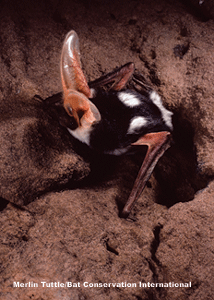Animal Fact Sheet: Spotted bat |
Identifying Features The spotted bat (Euderma maculatum) can be identified by is large ears which have a pinkish tone. Its body is jet-black in color with two large white spots on its shoulders and one white spot on its rump. The fur on its underbelly is snow white. The wings are also pink in color. |
 |
Migration/Hibernation Some spotted bats will migrate from colder to warmer regions in the winter. They will also go into a torpor in cold weather. This means that its body temperature will fall to that of their surroundings and its heart rate will slow. |
Habitat The spotted bat prefers arid regions, desert scrub, and open forest in rugged landscapes. They roost on vertical cliffs and in open canyons. Their habitat always seems to be associated with a water source such as a spring, creek, river or lake. |
Range This bat can be found from British Columbia, Canada southward thought the western United States and into Mexico. |
Wild Status This bat is considered to be one of the rarest bats in North America. That being said, it does occupy a very large range, but little is known about its wild status. It is considered to be a species of special concern. |
Diet The spotted bat is an insectivore, which means it eats a variety insects with moths being its food of choice. They tear off the wings of the moth and eat only the abdomen. |
Predators Owls, raccoons and skunks are a few of their natural predators. Human caused changes to their environment seem to be the biggest threat. Pesticide use that the bats may accumulate through their diet is of concern. |
Reproduction The female will give birth in June to usually only one pup. The pup does not have the distinctive color pattern of the adults when born. |
Life Span Many bat species are known to live in the wild for over 20 years. Not much is known about the life span of the spotted bat, but it it assumed to be within that range. |
Size Their body length is 4.0 to 4.50 inches (10.16-11.43 cm). Their wingspan is about 14 inches (35.56 cm)and they weigh 0.6-0.7 ounces (17.0-19.8 g) . |
Extra Fun-facts
|
 ©Copyright 2008, Arizona-Sonora Desert Museum
©Copyright 2008, Arizona-Sonora Desert Museum